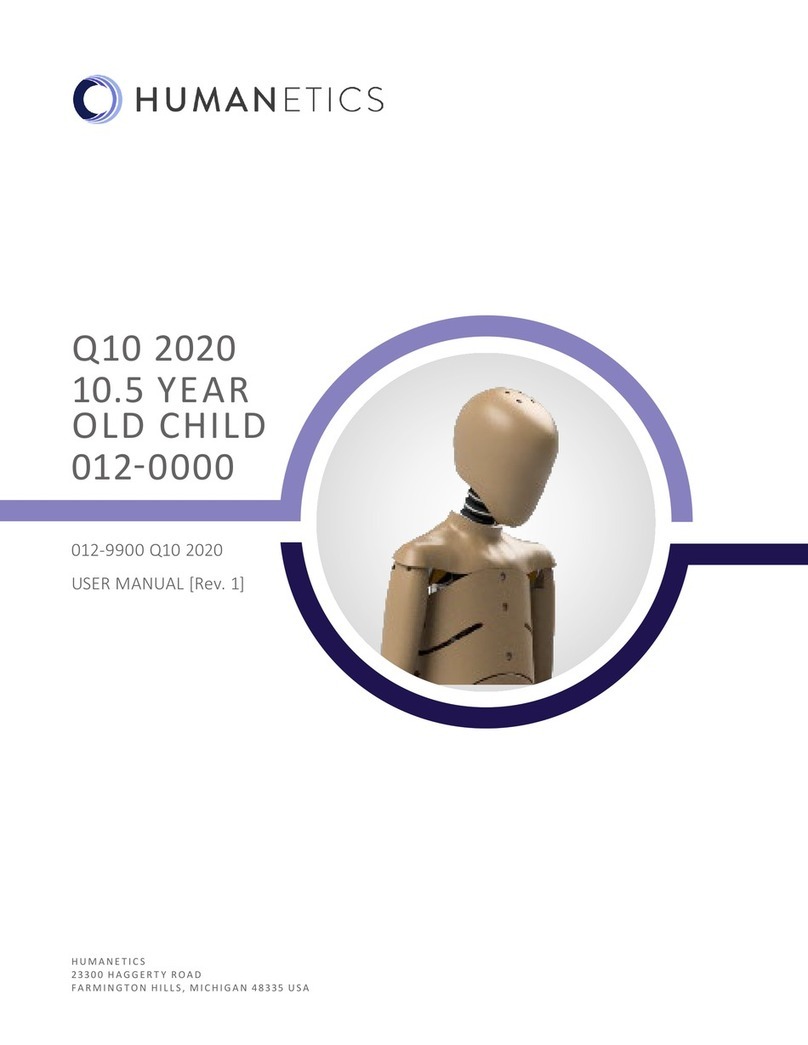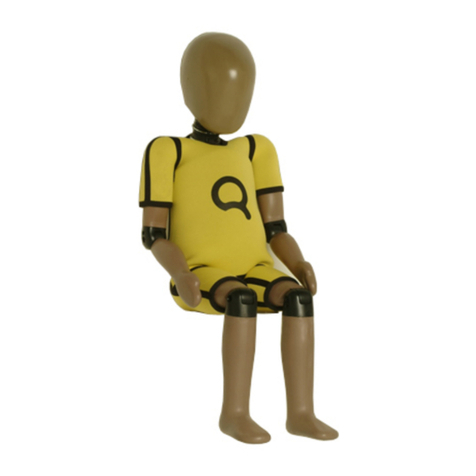
033-9900 User Manual Q6 (Advanced 6 year old) Rev. M
©2016 Humanetics Innovative Solutions Inc.
©
List of Figures
Figure 1. Q0 –Q6 dummies: from left to right Q1.5, Q3, Q0, Q6 and Q1.............................. 7
Figure 2. Accelerometer mounts for Q6 ......................................................................................... 18
Figure 3. Thorax uni-axial acceleration mounts I.AO (left) and I.AN (right)........................... 18
Figure 4. Pelvis uni-axial acceleration mounts I.AO (left) and I.AN (right) .............................. 18
Figure 5. Head uni-axial acceleration mounts I.AD (left) and I.AM (right)............................... 18
Figure 6. ATA ARS-01 (left) and ARS-06 (flanged version) (right)............................................. 19
Figure 7. DTS ARS’s on the special mount (DTS drawing TRIAX-M2D-1168) ...................... 20
Figure 8. Q6 Head instrumentation................................................................................................... 20
Figure 9. 40 mm APTS sensor ............................................................................................................ 21
Figure 10. CAD Picture of Q6 Abdomen showing ATPS sleeves assembled without sensors
and with foam plugs for certification.................................................................................................. 22
Figure 11. Q6 Head assembly (standard and optional instrumentation brackets shown)....... 26
Figure 12. Q6 Neck assembly ............................................................................................................... 29
Figure 13. Q6 Thorax assembly............................................................................................................ 33
Figure 14. IR-TRACC attachment hardware spine frontal (top left and right) and rib cage
side (bottom)........................................................................................................................................... 37
Figure 15. IR-TRACC should swing freely ......................................................................................... 38
Figure 16. Q6 side impact IR-TRACC arrangement........................................................................ 39
Figure 17. Lumbar spine assembly and abdomen.............................................................................. 43
Figure 18. Pelvis and hip joint assembly .............................................................................................. 45
Figure 19. Leg Assemblies ...................................................................................................................... 47
Figure 20. Arm Assemblies .................................................................................................................... 49
Figure 21. Neck Shield Installed: Left, Rear view; Right, Front view............................................ 52
Figure 22. Hip insert fitted on Q6: sitting position (left), straight legs (right) ........................... 53
Figure 23. Neck and lumbar spine head form test set-up for frontal test .................................. 62
Figure 24. Neck and lumbar spine head form test set-up for lateral test................................... 63
Figure 25. Q6 full-body impactor (accelerometer not shown) ..................................................... 65
Figure 26. Full body pendulum impactor suspension wire diagram.............................................. 66
Figure 27. Frontal Head drop certification set-up............................................................................ 70
Figure 28. Lateral Impact Head certification set-up –rear view of head.................................... 71
Figure 29. Q6 neck certification test set-up for frontal test.......................................................... 74
Figure 30. Q6 neck certification test set-up for lateral test........................................................... 76
Figure 31. Q6 lumbar spine certification test set-up for frontal test........................................... 80
Figure 32. Q6 lumbar spine certification test set-up for lateral test............................................ 82
Figure 33. Abdomen certification test set-up.................................................................................... 84
Figure 34. Neck Shield Installed and Removed ................................................................................. 86
Figure 35. Marker Positions on the Dummy...................................................................................... 92






























